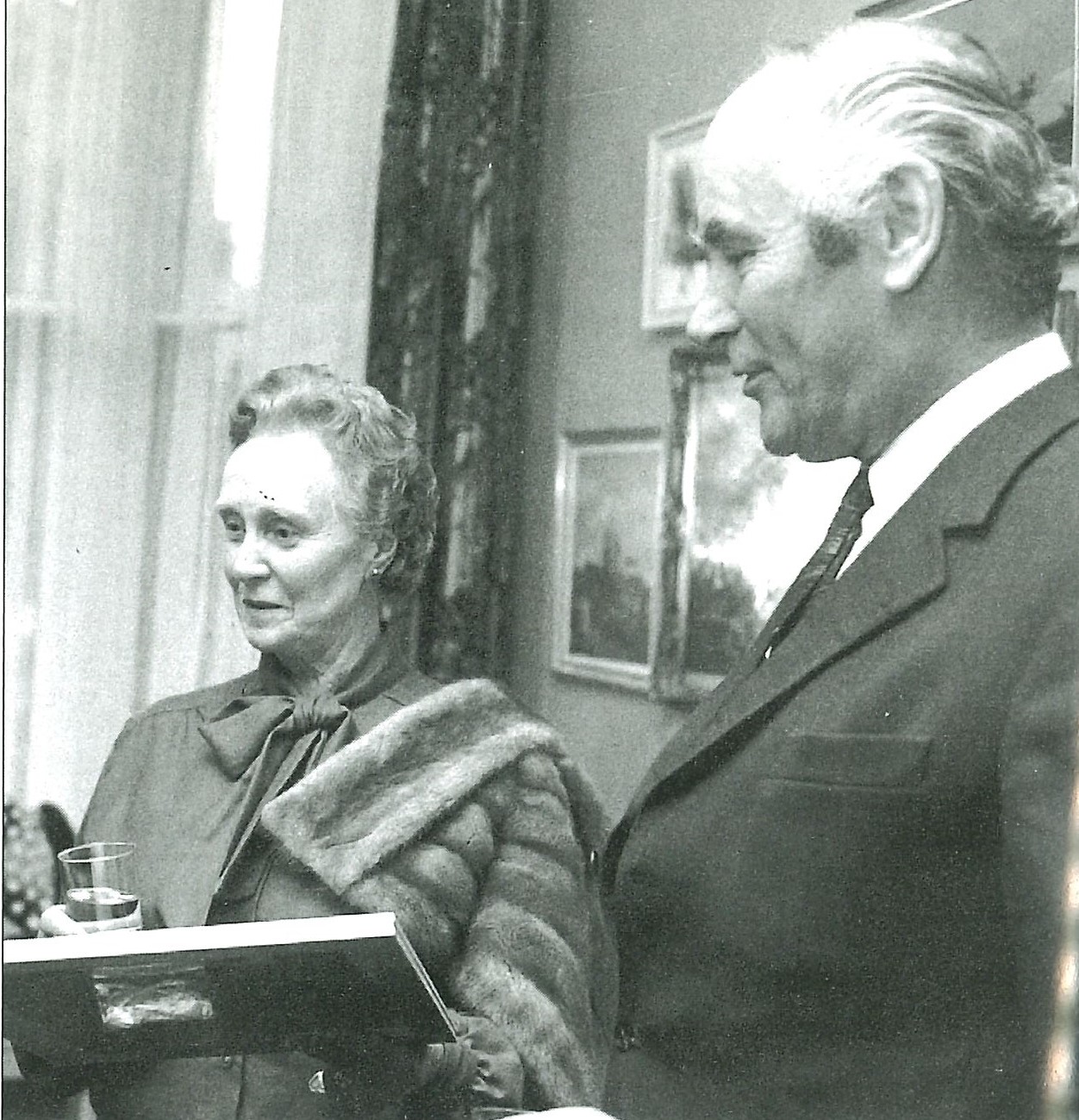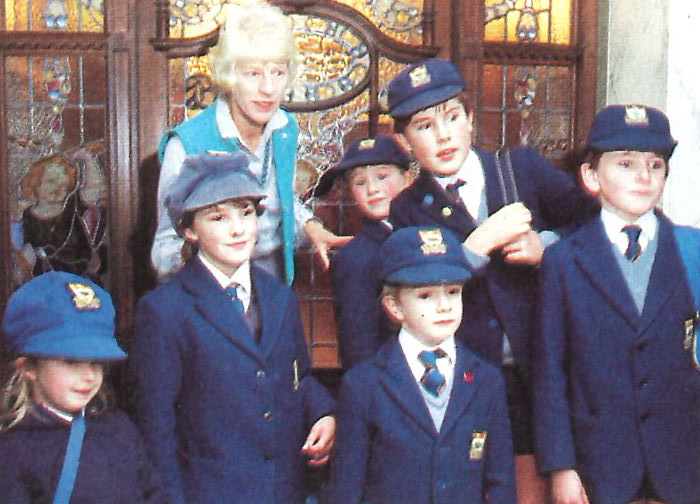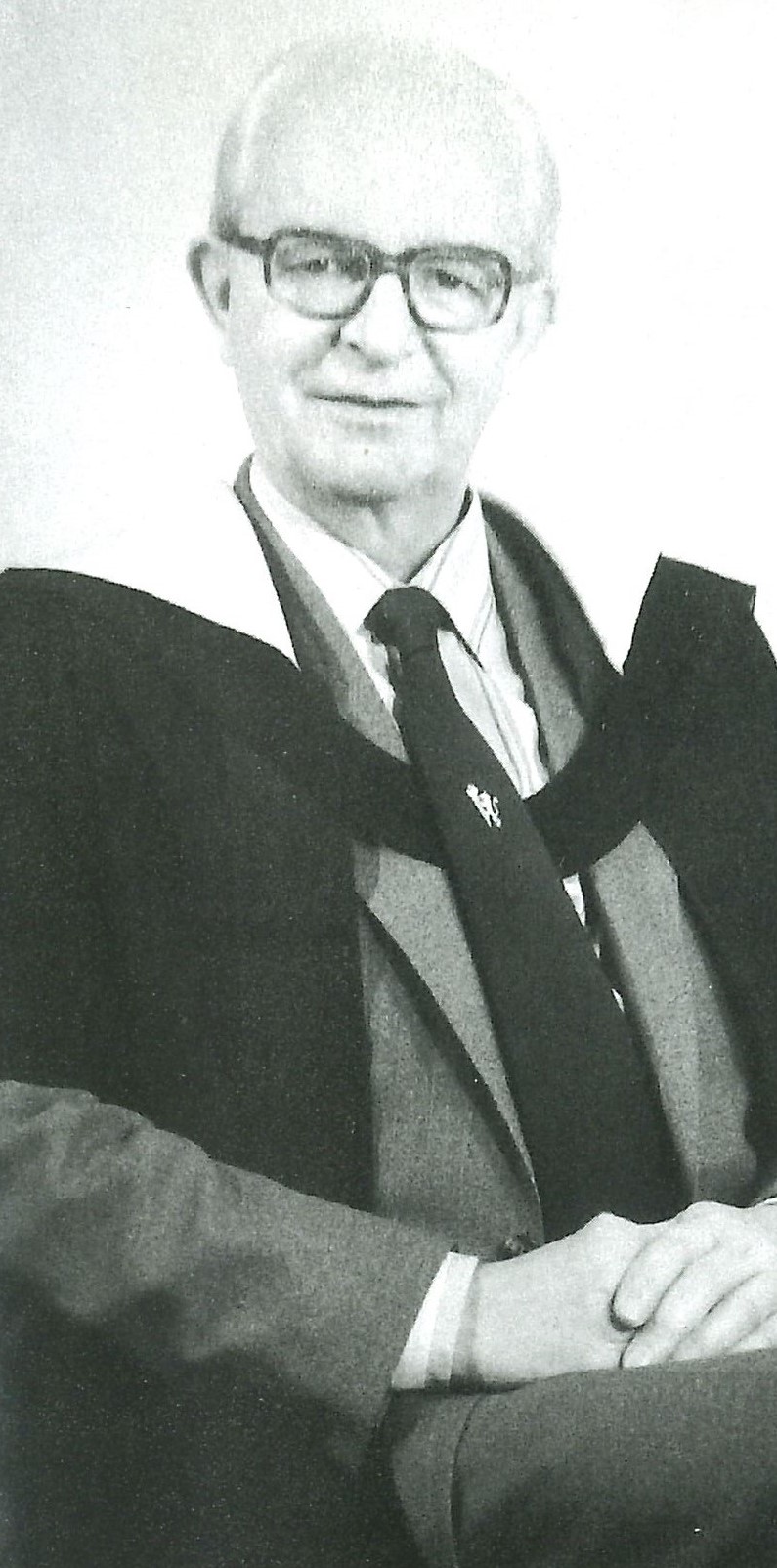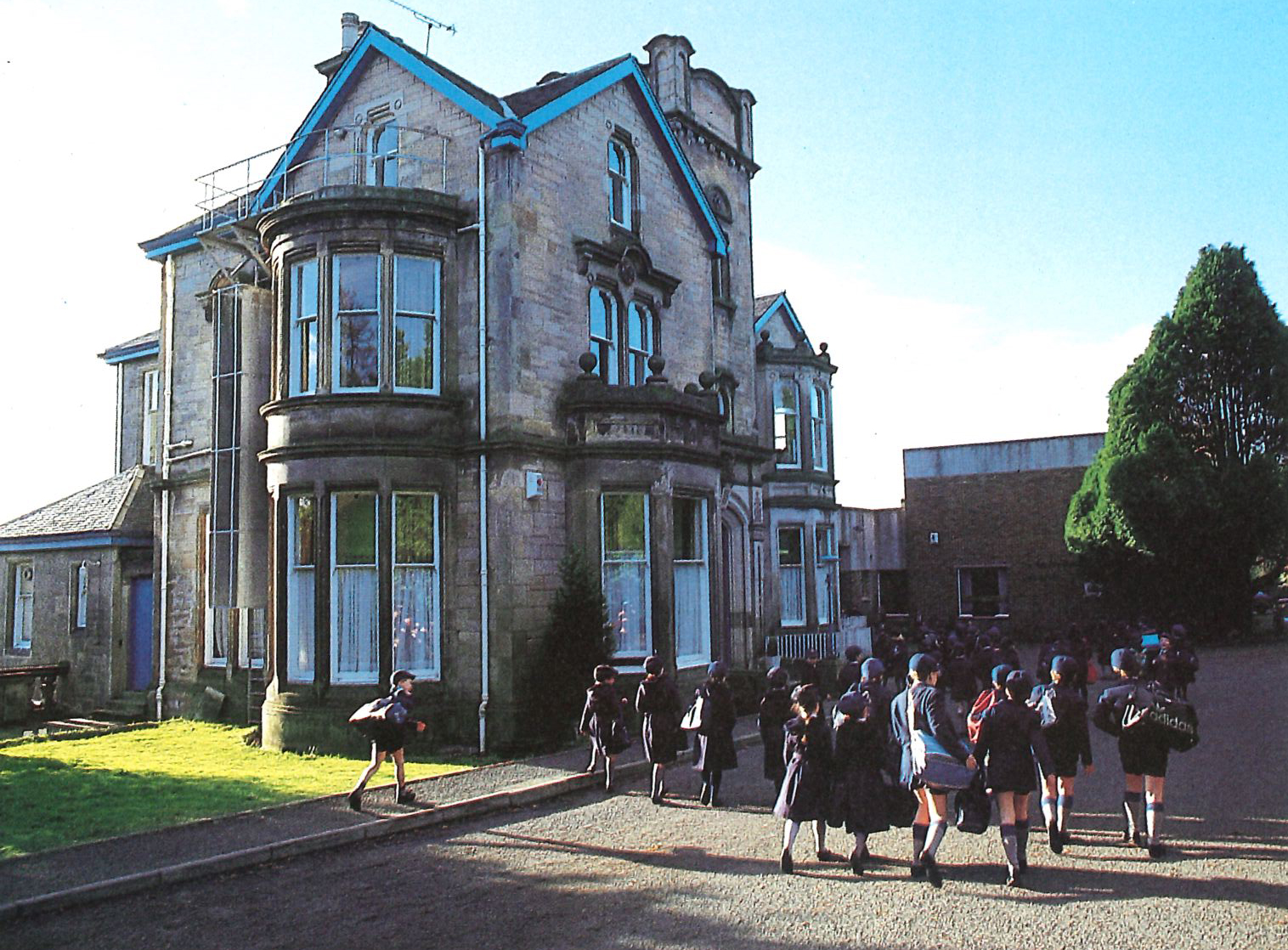HSOG History, Chapter 9: A partnership with Drewsteignton School
Our School’s illustrious history stretches back many centuries and has seen significant changes during this time. Not least was the closure of the former Boys’ School, latterly located on premises in Elmbank Street, in June 1976.
This month’s instalment of HSOG History delves a little into the birth of the “new” High School in the late 1970s, with a particular spotlight on the merger with Drewsteignton School in Bearsden, which today houses our Kindergarten and Junior School pupils.
Pictured above: the school buildings at 27 Ledcameroch Road, Bearsden which now houses the High School’s Kindergarten and Junior School (date unknown).
A history of Drewsteignton School
With the closure of the former Boys’ School a topical concern in the 1970s, a number of options were explored in order to ensure the continuation of the High School. The most promising involved coming to an arrangement with Drewsteignton School in Bearsden.
Founded in 1922 by Mrs Spencer Ponsford, Drewsteignton School aptly took its name from a small village near Exeter where her family had strong ties. It was initially a boarding primary school for girls and boys whose parents were based abroad and was first housed in Collylinn Road, Bearsden before relocating to purpose-built premises in Upper Glenburn Road two years later.
Following Mrs Ponsford’s death in 1958, her daughter, Mrs Thora Henderson, eventually made the decision to sell the school. Fears this would lead to its closure were rife, however, it was bought by an experienced teacher, Mrs Honor V Baker, who reopened Drewsteignton School in September 1962 with a role of fifteen pupils.

By 1968, an Educational Trust for Drewsteignton was formed with nine directors and one chairman, a post held by Mrs Baker’s husband, Andrew Baker. Come 1969, the school roll had grown to 160 and thus a decision was made to open a secondary day school.
Following successful fundraising efforts, Eric A Harle was appointed as the Head of Drewsteignton’s new Senior School in September 1971. The Senior School opened its doors at 27 Ledcameroch Road, Bearsden that very same year with 70 pupils from Primary 5 to Secondary 2 housed there.
Eighteen months later, a new wing at Ledcameroch Road was financed by the proceeds of enthusiastic fundraising efforts of parents and friends, ensuring the Senior School became well-established. This new wing was officially opened by former Glasgow Director of Education, Dr Stewart Mackintosh.
By April 1973, The High School of Glasgow was exploring its options to save its own school and therefore made an approach to Drewsteignton’s Board of Directors, who at that time were searching for property or land to aid in their plans of further expansion.
Coming to an agreement with Drewsteignton School
Come June 1973, Drewsteignton’s Board had reported on the advantages of a joint venture with the High School, namely the positive impact an association with a School with long-established traditions and significant assets would have, particularly in the then-competitive market where costs and fees were on the rise.
With a partnership between the two schools agreed, The High School Club Limited proceeded with applying for planning permission to Glasgow Corporation for the erection of a secondary school on premises located on Crow Road, with the intention that building works would be completed by 1977.
At this time, Drewsteignton was flourishing. From 1973 onwards, its school roll continued to grow with further buildings opened by a former Drewsteignton pupil, Sir Eric Yarrow, in November 1973 to accommodate the demand for places. In summer that same year, headmistress Mrs Frances Baker was replaced by Miss Eileen Robertson, who had been head-hunted by the Baker family themselves.

Discussions between the High School and Drewsteignton continued, however, with one particular sticking point – the name for the “new” school. Whilst Mrs Baker supported ‘Drewsteignton High School’ over fears that Drewsteignton would be swallowed up by the High School, on 14th September 1973 a decision was made to preserve the name ‘The High School of Glasgow’.
By January 1974, Drewsteignton Limited formally amalgamated its interests with the High School. Two-and-a-half years later, on 30th June 1976, the former High School at Elmbank Street officially closed its doors. The following day, Drewsteignton School assumed its new name and its Head of Senior School, Eric Harle, took up the post of Rector of the new High School of Glasgow.
With attention and resources primarily focused on the development of the new premises at Crow Road, spending on the Drewsteignton sites were, at first, kept to a minimum. However, by June 1975 it was clear that the accommodation was becoming unfit for purpose when the Baker family moved out of 14 Upper Glenburn Road to provide additional space.
The commencement of session 1975/76 saw a packed school roll, with 250 pupils from Kindergarten to P4 attending the Upper Glenburn Road site and a further 380 pupils attending from P5 to S6 at Ledcameroch Road.
Following persuasive discussions with Miss Eileen Robertson, the High School’s Board of Directors agreed in January 1977 that Ledcameroch Road should house Kindergarten to P6, whilst the rest of the School should attend the new campus at Old Anniesland.
To pay homage to the histories of both schools, further decisions were made regarding the embedding of certain traditions within school life. It was agreed that the former House names of Drewsteignton School (named after RNLI lifeboat stations across the UK: Broughty Ferry, Campbeltown, Lizard and Longhope) would be in place at the Junior School, whilst the Senior School would keep the names of the Houses from the then Elmbank Street (Bannerman, Clyde, Law and Moore).
On 28th September 1977, the new High School at Old Anniesland was officially opened by Lord Home of the Hirsel.
Transformational developments at the “new” Junior School
During the first half of 1982, Rector Eric Harle indicated his intentions to retire, and so recruitment began for his successor. On 16th November 1982, Dr Robin Easton (Head of Modern Languages at Watson’s College) was appointed as the next Rector of the High School.
Throughout his tenure (1983-2004), Robin Easton was committed to the fundraising efforts required to fund a myriad of improvements and developments. Eileen Robertson felt that the accommodation at the Junior School had been somewhat neglected due to the need to create the Senior School at Old Anniesland. As such, plans were drawn up to add a proper entrance to the Junior School, to provide a stage and hall as well as to create classrooms for Junior 6 pupils.


Architects Wylie Shanks were appointed to spearhead these projects, which, upon agreement by the Directors, were funded from the School’s own resources at a cost of £446,955. On 11th May 1990, Lady Macfarlane officially opened the new projects.
By May 1994, Easton had formulated further plans to ensure the High School maintained “its place in the forefront of Scottish education”, including the provision of a new Kindergarten area at the rear of the present Junior School buildings.
In addition, other plans included a purpose-built block for Junior 1 and Junior 2 at the rear of the 1973 extension and linked to the Kindergarten building, as well as a re-design of the rooms in the main building which, it was hoped, would create much-needed space for Junior 3-5 pupils. However, these plans hit a slight roadblock in achieving planning permission with Bearsden and Milngavie District Council due to the preference for the new Junior 1 and 2 block to be built on the playground instead.
In the meantime, Easton progressed plans for the conversion of the second floor of the former Rector’s flat into four Music practice rooms, whilst part of the first floor would become a new spacious Music room. These plans were drawn up by Class of 1953 former pupil, Robin Hagart, at an estimated cost of £70,000, which the Board subsequently approved.
Come February 1996, the initial Junior School developments were approved by the District Council, with the Board of Directors appointing Melville Dundas (Glasgow) a month later. On 9th April that same year, the Kindergarten extension work commenced and was completed by September, just in time for the start of the new session.

This paved the way for the developments to the Junior 1 to 5 classrooms. By good fortune, the High School was bequeathed the residue of the estate of a former pupil, Edith Macmillan, in memory of her grandfather. Her trustees decided it appropriate for a new building to be named in her honour and so Easton was able to progress with the new Junior 1 and 2 developments, at a cost of £1.3 million. In October 1999, the Macmillan Building was officially opened.
One final project remained for the Junior School – refurbishment of the Junior 3-5 classrooms – which Iain MacLaren of Wylie Shanks architects was instructed to draw up plans for.
Since then, the Junior School has undergone further transformations to improve its campus and facilities. Most recently, the Collaborative Working Zone was officially opened in November 2023 by former Chairman of the Board of Governors, Mr Brian Adair, in memory of his late wife Mrs Elaine Adair. You can read more about this project by clicking here.
Into the future, we intend to keep investing in the development of our Junior School accommodation and facilities to ensure we have an educational environment which is flexible, adaptable, sustainable and fit for an ever-changing future for our youngest learners.
Much of the information included within this article was sourced from The Town School, a book written by former member of staff, Brian Lockhart. Should you wish to read more about HSOG’s history, you can order a copy of his book on our website here: www.hsogcommunity.co.uk/shop/.

